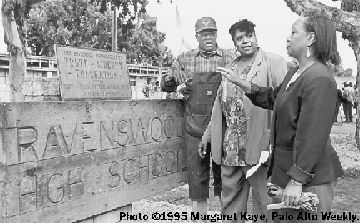Type Public high school Closed 1976 Team name Trojans Founded 1958 | Opened 1958 Enrollment 823 (1974) Yearbook Argonaut Number of students 823 (1974) Color Blue and yellow | |
 | ||
District | ||
Ravenswood high school east palo alto top 12 facts
Ravenswood High School was a public high school located in East Palo Alto, California, United States. Opened in 1958, it served the East Palo Alto area of San Mateo County until its closure in 1976. In 1958 its enrollment was 629 students. During the existence of Ravenswood, East Palo Alto was the low income area in the shadow of its more affluent neighbors Menlo Park, Atherton and Palo Alto. The city of Palo Alto, while adjacent and sharing the same zip code, is a completely different city in Santa Clara County. Ravenswood was part of the Sequoia Union High School District, which serves the southern San Mateo County cities of Belmont, Redwood City, San Carlos, and Woodside.
Contents
In 1971, Raymond J. Heringer, director of the work experience program at Ravenswood High, was awarded the John Wesley Powell Award.
During the early 1960s, the enrollment in the school increased from initially less than 800 to over 1,200 students. Due to white flight, 60 percent of the student population was African American. The next decade continued this trend. Almost a decade after the Brown v. Board of Education decision, the conditions at the school drew the attention of the Congress of Racial Equality (CORE) and the National Association for the Advancement of Colored People (NAACP). In the early 1970s, the school board instituted a district-wide busing program to increase the diversity of all its high schools. This was successful for a few years, but by the mid-70s, volunteer students wishing to attend Ravenswood became harder to find. Enrollment declined and, facing the financial burden of keeping the school alive, Ravenswood was closed in 1976. The location was demolished in 1995 to make room for the Gateway 101 Shopping Center.
With the closure of Ravenswood High School, instead of the school district complying with the Brown v. Board of Education (1954) and Mendez v. Westminster (1947) US Supreme Court rulings that a student is legally required to attend the closest school to their home, the predominantly African-American, Hispanic and Pacific Islander students were forced by the district to be bused to other high schools in the Sequoia High School District, including Carlmont, which had a predominantly Caucasian population at the time.
The Lawyers' Committee for Civil Rights of the San Francisco Bay Area, working with the law firm of Brigham McCutchen, submitted a 34-page report to the district school board in July 2013 about the illegalities of forcing the East Palo Alto students to be bused to Carlmont and other High Schools, instead of attending their closest school, Menlo-Atherton. In fear of a lawsuit, the district has slowly allowed East Palo Alto students to start attend high schools closer to home.
